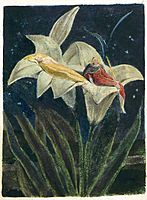Titania (A Midsummer Night's Dream) facts for kids
Quick facts for kids Titania |
|
|---|---|
| A Midsummer Night's Dream character | |
| Created by | William Shakespeare |
| Information | |
| Spouse(s) | Oberon |
Titania (/tɪˈtɑːniə/) is a character in William Shakespeare's 1595–1596 play A Midsummer Night's Dream.
In the play, she is the Queen of the fairies and wife of the Fairy King, Oberon. Due to Shakespeare's influence, later fiction has often used the name Titania for fairy-queen characters.
Origins
In traditional folklore, the fairy queen has no name. As such, Shakespeare took the name Titania from Ovid's Metamorphoses, where it is an appellation given to the daughters of Titans.
Role in the play
Shakespeare's Titania has a major role to play in one of A Midsummer Night's Dream's subplots.
Titania is a very proud creature and as much of a force to contend with as her husband, Oberon. She and Oberon are engaged in a marital quarrel over which of them should have the keeping of an Indian changeling boy. It is this quarrel which drives the plot, creating the mix-ups and confusion of the other characters in the play.
Due to an enchantment cast by Oberon's servant Puck, Titania magically falls in love with a "rude mechanical" (a labourer), Nick Bottom the weaver, who has been given the head of a donkey by Puck, who feels it is better suited to his character. While under the spell, Titania loses the powerful attributes she previously held and becomes fawning instead.
After Oberon and Puck have had enough of watching Titania make a fool of herself to woo "a monster", Oberon reverses the spell and the two reunite after Titania pronounces "what visions have I seen! Methought I was enamour’d of an ass." At the play's conclusion, Titania and Oberon lead a fairy blessing of the marriages of the play's protagonists.
Legacy
Titania has appeared in many other paintings, poems, plays and other works. In perhaps the earliest citation, Johann Wolfgang von Goethe included the figures from Shakespeare's work in Faust I in the 1770s, where she and her husband are celebrating their golden wedding anniversary.
Carl Maria von Weber then used the characters of Titania, Oberon and Puck in his opera with spoken dialogue composed in 1825–26, Oberon, but this time set during the reign of Charlemagne.
Alfred Lord Tennyson's play The Foresters, which is a Robin Hood story, from 1892 includes a brief segment with Titania, Queen of the Fairies.
Titania, one of Uranus's moons, was named after Shakespeare's character. All of its moons (including Oberon) are named for characters from the works of William Shakespeare or Alexander Pope.
Titania also appears in the cartoon Gargoyles, produced by Walt Disney Television Animation, which originally aired from October 24, 1994, to February 15, 1997. Oberon and Titania have been divorced for 1,001 years, but remarry during the course of the series. She is also revealed to be the true identity of Anastasia Renard, mother of the recurring antagonist Fox. Titania/Anastasia is voiced by Kate Mulgrew.
In the 1999 film adaptation of the play, Titania is played by Michelle Pfeiffer.
In 2016 Titania was added to the free-to-play action role-playing third-person shooter online game Warframe as the namesake of one of the titular Warframes, featuring razor-butterflies and assorted fairy-themed abilities.
In the manga and anime The Ancient Magus' Bride (魔法使いの嫁 Mahō Tsukai no Yome), which aired from October 2017 to March 2018, the Queen of the Fairies is named Titania. Her husband is also named Oberon.
In the manga and anime Fairy Tail, which was serialised from August 2006 to July 2017 and broadcast as a series from 2009 to 2019, the character Erza Scarlet carries the title of "Titania, Queen of the Fairies" because of her status as the most powerful of the female wizards in the Fairy Tail guild.
In the 2016 BBC adaptation for television, Titania is played by Maxine Peak. The version became known for the kiss between Titania and Hippolyta.
Titania is the one of the bases for one of the bosses in Mega Man Zero 4, a video game which was created in 2005. The character is called Sol Titanion, alongside an Atlas moth.
Titania is the Queen of the Summer Court of fairies in Jim Butcher's The Dresden Files series, the first instalment of which was published in 2005.
In Dark Princess by W. E. B. Du Bois, the author dedicates the book: "To Her High Loveliness Titania XXVII By Her Own Grace Queen of Faerie."
In Final Fantasy XIV: Shadowbringers, released on July 2, 2019, Titania appears as an opponent during the course of the story. In the fiction, the name "Titania" is actually a title held by the ruler of the faeries rather than being an individual name in and of itself.
Titania also appears in the Shin Megami Tensei series of video games as a recruitable Demon alongside her spouse Oberon.
In Vertigo Comics' The Sandman, which ran for 75 issues from January 1989 to March 1996, Titania rules Faerie with her mate Auberon and is a rumored one-time lover of the titular Lord of Dreams. One issue recounts that William Shakespeare created A Midsummer Night's Dream as a commission piece for Dream—who presents it to Titania as a gift to Faerie, so that the fey folk should not be forgotten in the Waking World.
-
One of William Blake's illustration to his The Song of Los. Scholars have traditionally identified the figures as Titania and Oberon, though not all new scholarship does. This copy, currently held by the Library of Congress, was printed and painted in 1795.


